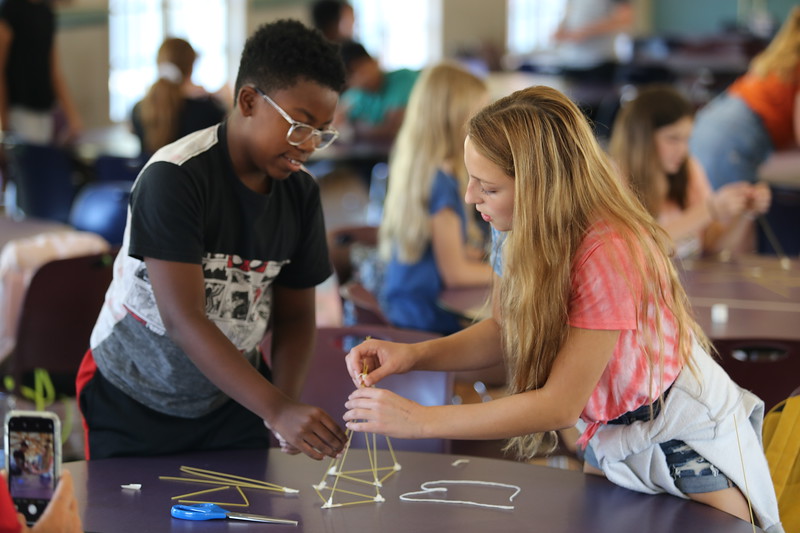By: Sophia , Jack , Colton
Proofread by:Remi, Asha, and Hannah
Monday: 5/20/19- Sophia
Today in Quest, we continued to work on our Global Challenge Project. The groups are in different places, so every group was doing something different. Some group tasks include finishing research, working on the visual aid, writing the pitch, practicing their presentation, or any other finishing touches. Tomorrow we have a practice presentation in front of the tenth-grade environmental science class for feedback before presenting to our assigned professional on Thursday.
My group is a global health group focused on outbreaks of pneumonia in India. Today, two out of the four of us worked on our solution, making a website and Instagram to promote the importance of getting vaccinated, especially for pneumonia in India. The other two of us worked on our poster, which will serve as our visual aid along with our website. Our group will continue to prepare for our presentations for homework.
Tuesday May 21, 2019- Colton
Today every group made their practice pitches to tenth-grade students. Before every group gave their pitch they had one class period to rehearse and make any needed adjustments to their projects. Every group made a 5-10 minute pitch then were given feedback on their overall project, solution, problem, and presentations. My group made our pitch to Mr. Kimberly and some of the students from the 10th-grade Environmental Science class. We got feedback on the cons of our project and how to make our case more sellable to the experts. After every group presented we got feedback from our own peers and teachers. In the following class periods, we used our feedback to make adjustments and improvements to our presentation and project.
My group is focusing on on the water crisis in Uganda. My group and I came up with a possible solution to the problem called the Omniprocessor. The Omniprocessor turns unclean water into clean drinking water for the people. The Omniprocessor evaporates the water and separates the sludge from the water. The steam is put through a cleaner and the sludge burned to create power. After the vapor is cleaned, it is bottled and handed out to the people in need. We presented our starting pitch and got good feedback for our final on Thursday.
Wednesday: 5/22/19- Sophia
Today in Quest, we are finishing up our Global Challenge Project. We continued to use the feedback from yesterday’s practice pitch to improve our projects. For some groups, the presentation to the expert is tomorrow, and for some, it’s Friday. This meant that most groups were finishing posters, (or other visual aids) adding information, or preparing and practicing their presentation. Everyone is making final touches to their project before the actual proposal to the professional arrives.
My group received lots of feedback from the tenth-graders, so we had a lot to do today. One piece of feedback was to directly state our problem and solution to ensure that it is clear to everyone. This encouraged our group to spend our first Quest period, making adjustments to what everyone said. We made it more clear what our problem and solution are and added more information to make our presentation longer. Now, all we have left to do before our pitch on Friday is finish our website (part of our solution) and practice a bunch.
Thursday 5-23-19 Colton
Today we presented our final pitch for the Global Project. Our expert in the topic was Alex Stark, a alumni of MFS 2006. Both of the water groups went to Mr. Greenberg’s room first period to present. The other group made their pitch on algae as a natural filtration. After they presented our group was up. We made our pitch about the Omniprocessor in Uganda. Mrs. Stark gave feedback to our idea and asked questions about it. I was really proud of both groups seeing what everyone’s hard work had turned into.
The following two Quest periods we spent filling out reflection sheets. There was a sheet on our group progress. The other sheet was an individual reflection sheet which asked us our opinion on the project and what we would do next time. The Global Project taught me to build an idea to a full scale project.
Friday 5-24-19 Jack
Today in quest our grade was finishing up the Global Challenge presentations. My groups topic was hunger. We specifically focused on Chad a country in Africa. Our solution was to make a protein bar so kids could get more nutrients. Our expert that we presented to was named Katie, she was all the way out in Colorado. But my group went yesterday, today we were working on a Global Challenge wrap up packet.
This packet had group questions and individual questions. First my group did the individual questions were everyone answered the questions by themselves. These questions were mainly focused on what did you improve on during your time doing the Golabel Challenge and what was the hardest part about the Global Challenge. These questions took up our first quest period so in the second period we did the group question. These question were mainly focused on what feedback you got. So my group answered all of those question.
Then in the time we had reaming in the last quest period we proofread our work. I liked this project a lot, I think in the beginning when all the teachers were explains it it sounded a lot harder than it was. I improved on my writing and collaborative work skills.
